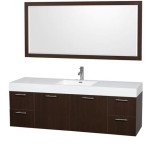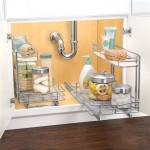How To Tile a Bathroom Countertop: A Comprehensive Guide
Tiling a bathroom countertop is a popular way to add style, durability, and value to a home. A tiled countertop offers a water-resistant surface that is relatively easy to clean and maintain. While it requires careful planning and execution, tiling a bathroom countertop is a project that can be tackled by a skilled DIYer. This guide provides a comprehensive overview of the process, from preparation to grouting.
I. Planning and Preparation
Before embarking on the tiling project, thorough planning is essential. This involves assessing the existing countertop, selecting appropriate tiles, and gathering the necessary tools and materials. The success of the project hinges on meticulous preparation.
Assessing the Existing Countertop: The existing countertop's condition will dictate the necessary preparation steps. If the existing countertop is laminate, it needs to be properly prepared to ensure the tile adhesive bonds correctly. This usually involves roughening the surface to provide a better grip for the adhesive. If the countertop is already tiled, the existing tile needs to be removed, and the underlying surface needs to be cleaned and leveled. Any loose or damaged areas need to be repaired before tiling can begin. A solid, stable base is paramount for a long-lasting tiled countertop.
Selecting the Right Tiles: The choice of tiles impacts both the aesthetics and functionality of the bathroom countertop. Consider factors such as tile material, size, shape, color, and texture. Common materials include ceramic, porcelain, glass, and natural stone. Ceramic and porcelain tiles are popular choices due to their durability, water resistance, and affordability. Glass tiles offer a unique aesthetic but may require more specialized installation techniques. Natural stone tiles, such as granite or marble, provide a luxurious look but can be more expensive and require sealing.
Tile size and shape influence the overall appearance of the countertop. Smaller tiles offer a more intricate look, while larger tiles create a cleaner, more modern aesthetic. Consider the size of the countertop when selecting tile size. Smaller countertops may benefit from smaller tiles to avoid excessive cutting. The shape of the tiles also plays a role. Square and rectangular tiles are the most common, but other shapes, such as hexagonal or mosaic tiles, can add visual interest.
The color and texture of the tiles should complement the overall bathroom design. Consider the color of the walls, cabinets, and fixtures when making tile selections. Light-colored tiles can brighten up a small bathroom, while darker tiles can add drama. Textured tiles can provide slip resistance, which is especially important around a sink.
Gathering Tools and Materials: Having all the necessary tools and materials on hand before starting the project streamlines the process and minimizes delays. Essential tools and materials include:
- Tiles
- Tile adhesive (thin-set mortar)
- Grout
- Tile spacers
- Tile cutter (wet saw or snap cutter)
- Notched trowel
- Rubber grout float
- Grout sponge
- Buckets
- Measuring tape
- Pencil
- Level
- Safety glasses
- Gloves
- Sealer (for grout and some tiles)
The type of tile adhesive and grout required will depend on the type of tiles being used. Consult the tile manufacturer's recommendations for specific product requirements.
II. Installing the Tiles
With the preparation complete, the next step is to install the tiles. This process involves applying the adhesive, setting the tiles, and ensuring proper alignment and spacing. Patience and precision are crucial during this phase.
Applying the Adhesive: Mix the tile adhesive according to the manufacturer's instructions. The consistency should be similar to peanut butter, allowing it to hold its shape without being too runny. Use a notched trowel to apply the adhesive to the countertop in small sections. The size of the notches on the trowel will depend on the size of the tiles. Hold the trowel at a 45-degree angle and create ridges in the adhesive. These ridges provide a better grip for the tiles. Do not apply adhesive to a large area at once, as it can dry out before the tiles are set.
Setting the Tiles: Carefully place the tiles onto the adhesive, pressing down firmly to ensure good contact. Use tile spacers to maintain consistent spacing between the tiles. The size of the spacers will depend on the desired grout line width. Regularly check the tiles for level using a level. If necessary, gently tap the tiles with a rubber mallet to adjust their height.
Cutting Tiles: Most tiling projects require cutting tiles to fit around edges, corners, and fixtures. Use a tile cutter (wet saw or snap cutter) to make these cuts. A wet saw provides a cleaner, more precise cut, especially for hard tiles like porcelain and stone. A snap cutter is suitable for softer tiles like ceramic. Always wear safety glasses when cutting tiles to protect your eyes from flying debris. Measure the area to be filled and mark the tile accordingly. When using a wet saw, slowly guide the tile through the blade, ensuring a smooth, even cut. When using a snap cutter, score the tile with the cutting wheel and then apply pressure to snap the tile along the score line.
Allowing the Adhesive to Cure: Once all the tiles are set, allow the adhesive to cure completely according to the manufacturer's instructions. This typically takes 24-48 hours. Avoid walking on the countertop or placing any heavy objects on it during this time.
III. Grouting and Sealing
After the adhesive has cured, the next step is to grout the tiles. Grouting fills the spaces between the tiles, creating a water-resistant seal and enhancing the overall appearance of the countertop. Sealing the grout helps to protect it from staining and moisture damage.
Applying the Grout: Mix the grout according to the manufacturer's instructions. The consistency should be similar to a thick paste. Use a rubber grout float to apply the grout to the tiles, working it into the spaces between the tiles. Hold the float at a 45-degree angle and apply firm pressure to ensure the grout fills all the gaps. Work in small sections and use a clean sponge to wipe away excess grout from the tile surfaces as you go. Rinse the sponge frequently in a bucket of clean water.
Cleaning the Grout: After the grout has had a chance to set for approximately 15-30 minutes, use a clean, damp sponge to remove any remaining grout haze from the tile surfaces. Rinse the sponge frequently in a bucket of clean water. Be careful not to remove too much grout from between the tiles. Allow the grout to cure completely according to the manufacturer's instructions. This typically takes 24-72 hours.
Sealing the Grout: Once the grout has cured, it is important to seal it to protect it from staining and moisture damage. Use a penetrating grout sealer and apply it according to the manufacturer's instructions. Apply the sealer evenly to the grout lines and wipe away any excess sealer from the tile surfaces. Some types of tile, particularly natural stone, may also require sealing to protect them from staining. Consult the tile manufacturer's recommendations for specific sealing requirements.
Final Cleaning and Inspection: Perform a final cleaning of the tiled countertop to remove any remaining grout haze or sealer residue. Inspect the countertop for any imperfections, such as cracked tiles or loose grout. Repair any imperfections as needed. Once the countertop is clean and free of imperfections, it is ready for use.
Special Considerations for Specific Tiles: Certain tile types require specific installation techniques. Glass tiles, for example, often require the use of a white thin-set mortar to avoid affecting their color. Natural stone tiles may require sealing before and after grouting. Consult the tile manufacturer's recommendations for specific installation guidelines for the type of tiles being used.
Addressing Common Problems: Several common problems can arise during the tiling process. These include uneven tile surfaces, cracked tiles, and grout discoloration. Uneven tile surfaces can be corrected by adjusting the amount of adhesive applied beneath the tiles. Cracked tiles should be replaced immediately. Grout discoloration can be caused by improper cleaning or the use of harsh chemicals. To prevent grout discoloration, use a pH-neutral cleaner and avoid using abrasive scrubbing pads.
Alternative Countertop Materials: While tile is a popular choice for bathroom countertops, other materials are available. These include granite, marble, quartz, concrete, and solid surface materials. Each material has its own advantages and disadvantages in terms of cost, durability, and aesthetics. Granite and marble are durable and luxurious but can be expensive and require sealing. Quartz is a durable and low-maintenance option that is available in a wide range of colors and patterns. Concrete countertops offer a unique, industrial look but can be prone to staining and cracking. Solid surface materials, such as Corian, are seamless and easy to clean but can be susceptible to scratching.

Tile Bathroom Countertops

Ceramic Tile Bathroom Countertops

Tile Countertops For Bathrooms And Kitchens The Good Guys

How To Paint Tile Countertops And Our Modern Bathroom Reveal Bright Green Door

How To Paint Tile Countertops And Our Modern Bathroom Reveal Bright Green Door
11 Tile Counter Ideas For Kitchens And Baths
:strip_icc()/101963997-428f882f0c604f7cb5e07f81516e96d9.jpg?strip=all)
18 Luxurious Bathroom Countertop Ideas For All Budgets

Tile Bathroom Countertops

How To Paint Tile Countertops And Our Modern Bathroom Reveal Bright Green Door

Full Bathroom Remodel Part 7 Tile Counter With Sink
Related Posts







